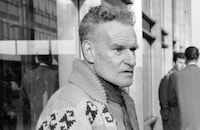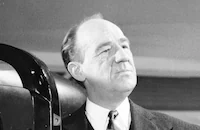The Yellow Rolls-Royce

Brief Synopsis
Cast & Crew
Anthony Asquith
Rex Harrison
Jeanne Moreau
Edmund Purdom
Michael Hordern
Lance Percival
Film Details
Technical Specs

Synopsis
FIRST EPISODE: The Marquess of Frinton buys a yellow Rolls-Royce for his wife as an anniversary gift and presents it to her at their dinner party. At Ascot Heath, the marquess' horse wins the gold cup, but the marchioness disappears. Lady St. Simeon informs him that his wife is having an affair, and the marquess finds her with her lover in the back seat of the Rolls-Royce. Unable to divorce his wife because of his position in the Foreign Office, the marquess sells the car instead. SECOND EPISODE: The next owner of the Rolls is American gangster Paolo Maltese, who purchases the car while he and his moll, Mae Jenkins, are vacationing in Italy. Mae is bored with the trip, and when Paolo returns to the States on business, she has an affair with Stefano, a handsome young photographer. Realizing that Stefano would be in danger if Paolo should return, Mae foregoes her love for Stefano and returns to her gangster life. THIRD EPISODE: Mrs. Gerda Millett, a wealthy American widow traveling to Yugoslavia with her dowdy companion, Miss Hortense Astor, whimsically purchases the yellow Rolls-Royce, intending to drive it to a party given by royalty. En route she is stopped by Yugoslav patriot Davich, who persuades her to smuggle him across the border to escape a Nazi attack. Mrs. Millett undertakes this task without enthusiasm until the Nazis bomb her hotel; she then joins the patriots and risks her life to aid their cause. Once again, the back seat of the Rolls-Royce is the setting when Davich makes love with Mrs. Millett, but he then sends her back to Miss Hortense.

Director

Anthony Asquith
Cast

Rex Harrison

Jeanne Moreau

Edmund Purdom

Michael Hordern
Lance Percival

Roland Culver

Moira Lister
Harold Scott
Richard Pearson

Isa Miranda
Grégoire Aslan
Jacques Brunius
Richard Vernon
Reginald Beckwith
Tom Gill
Dermot Kelly

Shirley Maclaine

George C Scott

Alain Delon

Art Carney
Riccardo Garrone

Ingrid Bergman

Omar Sharif

Joyce Grenfell

Wally Cox
Carlo Croccolo
Guy Deghy
Martin Miller
Andreas Malandrinos
Crew
Douglas Adamson
Philip Barnikel
Jackie Breed
Timothy Burrill
Pierre Cardin
Carita
Pamela Carlton
Castillo
Frank Clarke
Gene Coffin
Pamela Cornell
Anatole De Grunwald
Austin Dempster
Gerry Fisher
Giorgio Di Roma
Kip Gowans
Sydney Guilaroff
Edith Head
Jack Hildyard
Tom Howard
John Jarvis
Joan Johnstone
William Kellner
Jimmy Komisarjevsky
Vincent Korda
Anthony Mendleson
Norman Newell
John O'gorman
Riz Ortolani
Riz Ortolani
Roy Parkinson
Terence Rattigan
Elliot Scott
J. B. Smith
Tom Smith
Cyril Swern
A. W. Watkins

Videos
Movie Clip



Trailer
Hosted Intro



Film Details
Technical Specs

Articles
The Yellow Rolls-Royce
The Rolls-Royce, manufactured in Britain, represented the ultimate in luxury, style, and quality. And the film aspired to be the Rolls-Royce of movies: elegant, classy, and discreetly sexy. The Rolls-Royce used in the film was a pale blue 1930 Phantom II Sedanca de Ville, which MGM technicians covered with 20 coats of yellow paint. MGM focused as much publicity on the car as it did on the flesh-and-blood stars. It even produced The Car That Became a Star (1965), a documentary-like promotional short about the making of The Yellow Rolls-Royce, which gave the Rolls top billing.
In the first episode of The Yellow Rolls-Royce, titled British diplomat Rex Harrison buys the car for his French wife, Jeanne Moreau. And while he dallies with the horses at Ascot, she dallies with her husband's colleague (Edmund Purdom) in the Rolls. Parts of this sequence were shot on location at Ascot, and the exteriors of the couple's country estate were shot at Lord Astor's country house, Cliveden. The house had become notorious the previous year as the scene of the real-life escapades which brought down the British government in the sex-and-espionage scandal known as the Profumo Affair.
In the second story, Italian-American gangster George C. Scott tours his ancestral homeland with his gum-chewing blonde moll Shirley MacLaine. When he returns to America to take care of business, MacLaine gets involved with handsome Italian photographer Alain Delon. Art Carney, in his first feature film lead in years after playing Jackie Gleason's sidekick on television, appeared as Scott's henchman and MacLaine's sympathetic chauffeur (Carney had previously appeared in a bit part in the 1941 film, Pot o' Gold).
For Delon, 1964 was his breakout year into international stardom. After seven years in French and Italian films, Delon was France's highest-paid star. He had taken control of his career by setting up his own production company, and by branching out into English-language films. Delon followed up The Yellow Rolls-Royce, a British production, with Once a Thief (1965) opposite Ann-Margret and several international productions such as Lost Command (1966). By the early 70's he was as busy producing as acting.
Omar Sharif had become an in-demand international star in Lawrence of Arabia (1962). The third episode of The Yellow Rolls-Royce teamed him with Ingrid Bergman, playing a rich American widow who uses the Rolls to help Yugoslavian freedom fighter Sharif. A.H. Weiler in the New York Times had few kind words for the film, but did like their chemistry: " Miss Bergman and Omar Sharif manage to give this somewhat improbable {episode} a lift by energetic and humorous delineations."
Besides the charms of the starry cast, The Yellow Rolls-Royce offered other attractions: gorgeous location photography, designer wardrobes, and a catchy theme song, "Forget Domani," which won a Golden Globe Award for best song. In spite of tepid reviews, The Yellow Rolls-Royce performed respectably at the box office. The London Sunday Telegraph summed up the reason why: "anyone willing to be taken for a smooth ride could hardly find a more sumptuous vehicle, star-studded, gold-plated, shock-proof and probably critic-proof, too."
Director: Anthony Asquith
Producer: Anatole de Grunwald
Screenplay: Terence Rattigan
Cinematography: Jack Hildyard
Editor: Frank Clarke
Costume Design: Antonio Castillo, Edith Head, Pierre Cardin, Gene Coffin, Anthony Mendleson
Art Direction: Elliot Scott, Vincent Korda, William Kellner
Music: Riz Ortolani
Principal Cast: Rex Harrison (Marquess of Frinton), Jeanne Moreau (Marchioness of Frinton), Edmund Purdom (John Fane), Shirley MacLaine (Mae Jenkins), George C. Scott (Paolo Maltese), Alain Delon (Stefano), Art Carney (Joey Friedlander), Ingrid Bergman (Gerda Millet), Omar Sharif (Davich).
C-123m. Letterboxed.
by Margarita Landazuri

The Yellow Rolls-Royce
The Yellow Rolls-Royce - Shirley MacLaine, George C. Scott, Ingrid Bergman and an All-Star Cast in THE YELLOW ROLLS-ROYCE
Much of the film is filmed on picturesque European locations. Unfortunately, the seven top stars are thrown together with little thought as to screen chemistry, and much of the show just doesn't come together. The Yellow Rolls-Royce's only really lasting contribution is Riz Ortolani and Norman Jewell's bouncy pop tune Forget Domani.
A black & yellow luxury automobile is the narrative focus linking three otherwise unrelated romances. Each of the episodes recounts an ill-fated love affair. Diplomat Lord Frinton (Rex Harrison) buys the new Rolls-Royce as an anniversary gift for his wife, the Lady Eloise (Jeanne Moreau). But Eloise uses the car to conduct an affair with one of her husband's employees, Edmund Purdom. A number of years later the Rolls turns up in Naples. Vacationing Yankee gangster Paolo Maltese (George C. Scott) buys it to tour Italy with his fiancée Mae Jenkins (Shirley MacLaine). When Paolo returns stateside to rub out a gangland competitor, Mae falls for Stefano, a handsome gigolo (Alain Delon). Ten years later, American philanthropist Gerda Millett (Ingrid Bergman) acquires the Rolls to take her from Italy to Yugoslavia, even though she's been warned of an imminent German invasion. Undaunted by bombs and threats, Gerda smuggles a freedom fighter named Davich (Omar Sharif) across the frontier. Gerda then volunteers the car for wartime use, shuttling Davich's Yugoslav partisans to the front line.
The Yellow Rolls-Royce's three stories not only don't connect, they don't cohere in theme or purpose; this isn't a Motor Trend version of La Ronde. None of the actors do bad work, but neither are they taxed in any way -- the short story format allows time to establish characters, but not to develop them. Jeanne Moreau's faithless wife isn't very appealing, and Shirley MacLaine's gangster's moll is the kind of part she can do in her sleep. Ingrid Bergman gives her society adventuress a good try, but her romance with Omar Sharif doesn't progress past the introductions phase.
The handsome Sharif makes almost no impression. George C. Scott resists hamming it up; his racketeer sings O Sole Mio on the street but can't get his dime-store girlfriend to appreciate the leaning tower of Pisa. Alain Delon's "simple street hustler" character seems phony from the get-go. Working hard at being British and fussy, Rex Harrison fares the best. We momentarily care for his feelings when he realizes he's being cuckolded. A few supporting characters stand out just as strongly. Art Carney shows promise as the gangster's buddy, who becomes MacLaine's watchdog when she strays. Joyce Grenfell made a career of playing addled Englishwomen with funny voices. Here she affects an American Southern accent. Popping up too briefly in Ingrid Bergman's episode is the always-welcome Wally Cox. If Bergman had snubbed Omar Sharif for an affair with the ex- Mister Peepers, the movie might have yielded some surprises.
The show certainly does not lack for production values. In England we watch the Queen's ceremonial guards and spend an afternoon at the Ascot Racecourse. Italy is a procession of postcard views of Naples, Florence and Rome. But it's disturbing to see many scenes blocked and directed to minimize the production time on location for the film's seven stars. Most of their work takes place on studio sets, shots inter-cut with handsome footage filmed at the racetrack or in the Italian mountains. Ingrid Bergman's segment is basically a road movie, but she appears in only a couple of exterior locations. When Bergman delivers Sharif to his enthusiastic comrades, she's seen only in cutaways almost certainly filmed weeks before or after, on a studio's back lot. At least ten minutes of The Yellow Rolls-Royce are second-unit views of the stately title car cruising through the countryside or racing down narrow mountain roads, and we quickly realize that the name actors aren't really present.
Warners' attractive disc of The Yellow Rolls-Royce is a colorful enhanced transfer of a show that's perfect for film fans with an interest in its truly stellar cast. The mono track is clear and bright. Composer Riz Ortolani's wife Katyna Ranieri sings the Golden Globe-winning song Forget Domani. Ortolani's rise in the ranks of international film composers began with his surprise hit song More, from the wildly successful pseudo-documentary Mondo Cane two years before. The only disc extra is the original trailer.
For more information about The Yellow Rolls-Royce, visit Warner Video. To order The Yellow Rolls-Royce, go to TCM Shopping.
by Glenn Erickson
The Yellow Rolls-Royce - Shirley MacLaine, George C. Scott, Ingrid Bergman and an All-Star Cast in THE YELLOW ROLLS-ROYCE
Quotes
Trivia
The Rolls-Royce used in the film was a pale blue 1930 Phantom II Sedanca de Ville, which M-G-M technicians covered with 20 coats of yellow paint; a few coats of black were added to the top of the hood, the roof, and the wings.
In October 2003, the Chicago Tribune reported that the yellow Rolls-Royce is owned by Neal Kirkham of Saratoga, California, USA.
Notes
Filmed on location in England, Italy, and Austria. Opened in London in December 1964; running time: 122 min.

Miscellaneous Notes
Released in United States 1964
Released in United States 1964














